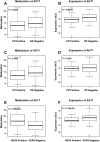Integrated analysis of promoter mutation, methylation and expression of AKT1 gene in Chinese breast cancer patients
- PMID: 28301567
- PMCID: PMC5354459
- DOI: 10.1371/journal.pone.0174022
Integrated analysis of promoter mutation, methylation and expression of AKT1 gene in Chinese breast cancer patients
Abstract
Background: As downstream mediators of PI3K /PTEN /AKT /mTORC1 pathway, the AKT isoforms play critical roles in tumorgenesis. Although the pleiotropic effects of AKT1 in breast cancer have been reported, the genetic and epigenetic characteristics of AKT1 promoter region in breast cancer remains to be identified. In this study we aimed to investigate the promoter mutation spectrum, methylation and gene expression pattern of AKT1 and their relationship with breast cancer.
Methods: By using PCR target sequence enrichment and next-generation sequencing technology, we sequenced AKT1 promoter region in pairs of breast tumor and normal tissues from 95 unselected Chinese breast cancer patients. The methylation of the promoter region and the expression profile of AKT1 in the same cohort were detected with bisulfite next-generation sequencing and qPCR, respectively.
Results: We identified 28 somatic mutations in 23 of the 95 (24.2%) breast cancer samples. And 19 of the 28 mutations were located in transcription factor (TF) binding sites. In the 23 patients with somatic mutations, no significant change of methylation or expression was found comparing with other patients. AKT1 promoter region was significantly hypo-methylated in tumor compared with matched normal tissue (P = 0.0014) in the 95 patients. The expression of AKT1 was significantly suppressed in tumor tissue (P = 0.0375). In clinicopathological factor analysis, AKT1 showed significant hypo-methylation (P = 0.0249) and suppressed expression (P = 0.0375) in HER2 negative subtype. And a trend of decrease in expression level (P = 0.0624) of AKT1 in the ER negative subtype was observed, which is significantly decreased in basal-like breast tumor (P = 0.0328).
Conclusions: Hypo-methylation and suppressed expression of AKT1 was observed to be associated with breast cancer in our cohort. The methylation and expression of AKT1 were both significantly associated with HER2 status. The promoter mutation of AKT1 did not show significant association with its methylation and expression status. These results suggested that the promoter mutation, methylation and gene expression of AKT1 may play distinct roles in tumorgenesis of breast cancer and the integrated analysis of methylation and expression of AKT1 might serve as potential biomarkers for diagnosis and classification of breast cancer.
Conflict of interest statement
Figures




References
-
- Goldhirsch A, Winer EP, Coates AS, Gelber RD, Piccart-Gebhart M, Thurlimann B, et al. Personalizing the treatment of women with early breast cancer: highlights of the St Gallen International Expert Consensus on the Primary Therapy of Early Breast Cancer 2013. Annals of oncology: official journal of the European Society for Medical Oncology / ESMO. 2013;24(9):2206–23. - PMC - PubMed
-
- Garber JE, Offit K. Hereditary cancer predisposition syndromes. Journal of clinical oncology: official journal of the American Society of Clinical Oncology. 2005;23(2):276–92. - PubMed
MeSH terms
Substances
LinkOut - more resources
Full Text Sources
Other Literature Sources
Medical
Research Materials
Miscellaneous

